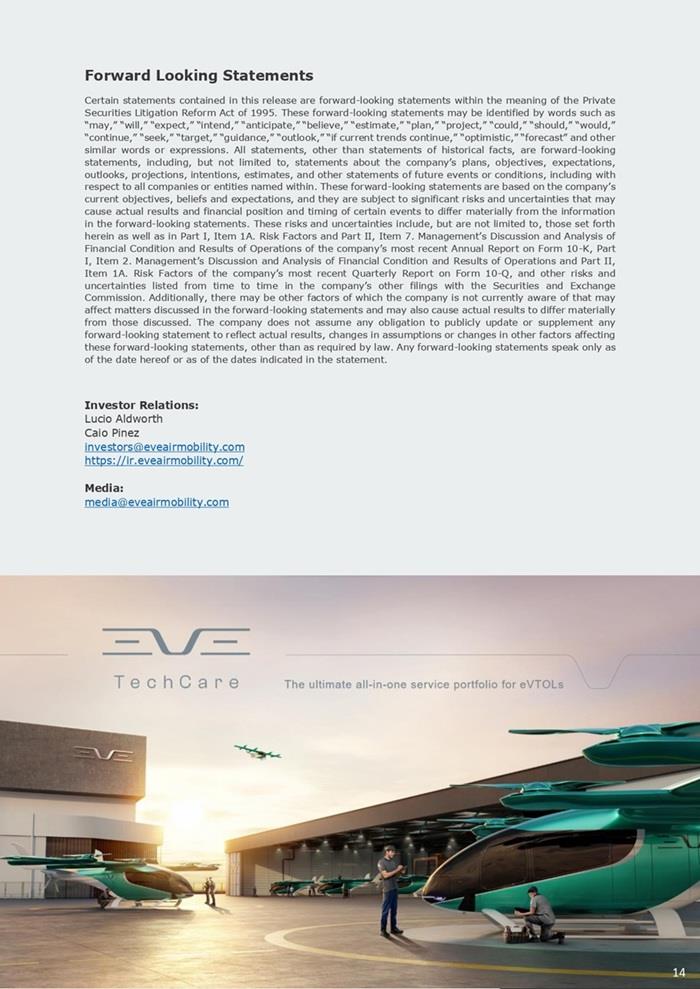Eve Air Mobility Third Quarter 2024 Results November 4, 2024 eveairmobility.com
..com
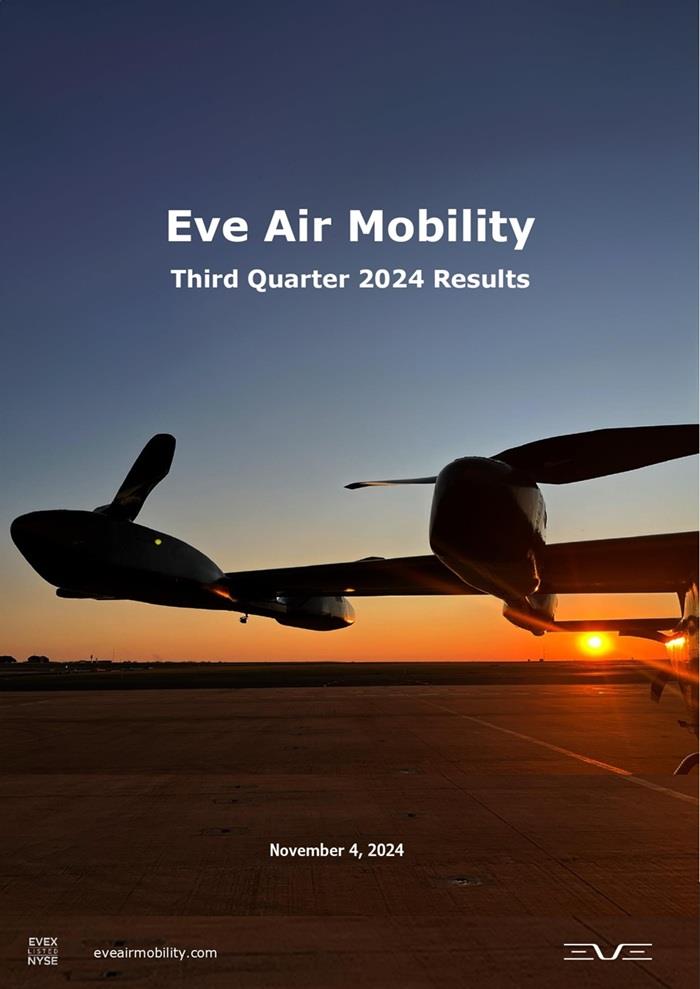
Eve Holding, Inc.
Third Quarter 2024
Financial Highlights
Eve Air Mobility is an aerospace company dedicated to the development of an eVTOL (electric Vertical Takeoff
and Landing) aircraft and the Urban Air Mobility (UAM) ecosystem that includes aircraft development, Customer
Services and Vector, an Urban Air Traffic Management (Urban ATM) system. Eve is pre-revenue; we do not expect
meaningful revenues, if any, during the development phase of our aircraft, and we expect financial results to be
mostly related to costs associated with the program’s development during this period.
Eve reported a net loss of $35.8 million in 3Q24 versus $31.2 million in 3Q23. Net loss increased due to higher
Research & Development (R&D) – these are costs and activities necessary to advance in the development of our
suite of products and solutions for the Urban Air Mobility (UAM) market, as well as Selling, General &
Administrative (SG&A) expenses. R&D expenses were $32.4 million in 3Q24, versus $28.6 million in 3Q23 and
were primarily driven by the Master Services Agreement (MSA) with Embraer who performs several development
activities for Eve. These efforts continue to intensify with increasing maturity of the development of our eVTOL.
Moreover, engagement of our engineering team continues high – after the roll-out of our engineering prototype
in July, who are now performing a series of system and integration ground tests on the aircraft before its debut
flight.
In the meantime, SG&A increased to $8.4 million in 3Q24, from $5.0 million in 3Q23, primarily due to a
combination of higher outsourced services, payroll costs and pre-operating industrialization costs associated with
our first eVTOL plant, in the city of Taubaté in Brazil. These increases were partly offset by savings on Director
& Officers insurance expenses after renegotiating and lengthening terms with our provider and a c.8%
depreciation of the Brazilian Real (BRL) vs. the USD over the last year. Most of SG&A expenses are incurred in
Brazilian currency. The growth in payroll expenses reflects mostly an increase in Eve’s headcount.
The increase in R&D and SG&A was partly offset by a $4.0 million gain in 3Q24 related to the fair value of
derivatives (as private warrants were marked to market), vs. a $0.9 million loss in 3Q23. Eve’s total cash used
by operations and capital expenditures in 3Q24 was $34.0 million, vs. $22.4 million in 3Q23. R&D expenses
associated with Eve’s development were the main contributors to the higher cash consumption during the quarter.
Eve’s Cash, Cash Equivalents and Financial Investments totaled $279.8 million at the end of 3Q24, and liquidity**
reached $305 million, including $25 million from the BNDES R&D standby facility available. Subsequent to 3Q24,
Eve secured a new ~$90 million credit line with the BNDES – Brazil’s National Development Bank, to support the
necessary investments in our Taubaté site, and a new $50 million loan with Citibank to support the funding of
R&D. The additional funding will strengthen our Balance Sheet and support our operations and program
investments in the upcoming years.
Key Financial Indicators
Eve Holding, Inc.
Third Quarter 2024
USD MILLIONS 3Q24 3Q23 9M24 9M23
INCOME STATEMENT
Research & Development (R&D) (32.4) (28.6) (96.2) (72.0)
Selling, General & Administrative (SG&A) (8.4) (5.0) (20.3) (17.8)
Change in fair value of derivative liabilities 4.0 (0.9) 12.4 (9.8)
Interest Income / Other Non-Operating Expenses, net 1.5 4.4 8.1 12.8
Net Earnings / (Loss) (35.8) (31.2) (97.5) (88.4)
CASH FLOW
Net Cash Used in Operating Activities (30.7) (22.4) (97.3) (70.0)
Net Additions to Property, Plant and Equipment (PP&E) (3.2) (0.0) (4.0) (0.2)
Free Cash Flow* (34.0) (22.4) (101.3) (70.2)
Net Cash (Used) Provided by Financing Activities 108.8 11.0 137.8 10.7
9M24 FY23
BALANCE SHEET
Other Assets 9.7 4.2
Total Payables 56.0 40.6
Cash, Cash Equivalents, Fin. Investments and Rel. Party Loan Receivable (Beg. of period) 241.1 310.6
Cash, Cash Equivalents, Fin. Investments and Rel. Party Loan Receivable (End of period) 279.8 241.1
Total Debt 68.3 25.8
Total Liquidity** 305.2 316.3
* Free Cash Flow is a non-GAAP measure and includes Net Cash Used in Operating Activities, Net Additions to PP&E
** Total Liquidity is a non-GAAP measure and includes Cash, Cash Equivalents, Financial Investments, Related Party Loan Receivable, undrawn BNDES R&D standby facilities
eveairmobility.com
1
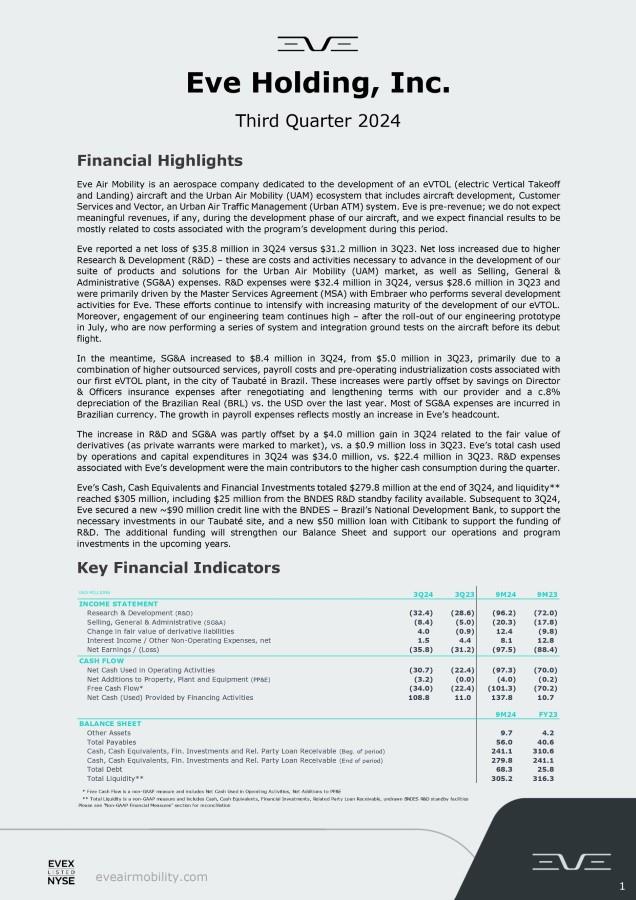
Program Development
Following the roll-out of our full-scale prototype in early July, our engineering team continues to make significant
progress with the development of our eVTOL. Since then, we have installed the batteries and initiated a series
of tests to ensure that all the many systems are properly integrated amongst each other for a seamless flight
campaign. These include – among others, Flight Test Instrument (FTI) integration to validate proper system
conformity as well as the dedicated radio link between the Command & Control truck and the Prototype.
Importantly, our prototype was designed and built with multiple custommade carbon-fiber panels. The “skin” was designed to be easily
maintained with removable panels to facilitate access to internal
components. Engineers have easy access to the battery pack, flight
computers and all other flight-critical electric and electronic systems,
downloading of telemetry, repairs and any maintenance that might be
required.
We have performed Antenna Signal Tests to complete the integration of
the Command & Control truck to the aircraft. The truck will house the
pilot and the team of engineers who will measure and monitor several
operating metrics during the flights. The truck is designed to track the
eVTOL during its test flights and is equipped with several telemetry
sensors and cameras strategically placed throughout the eVTOL fuselage
to provide real-time flight performance data, visuals and diagnostics.
The goal is to guarantee that all systems are working seamlessly
amongst each other and minimal – if not zero, signal latency and
interruptions. This will guarantee optimal vehicular control, high fidelity
in data analysis and performance for continued aircraft development in testing phase.
As a reminder, the prototype was assembled at Embraer’s Gavião Peixoto site
(GPX). This is also where the flight tests and flight-test campaign will be conducted
and is home to Embraer’s defense division, parts of the executive aviation assembly
line and the largest runway in the southern hemisphere. This is a 5-kilometer (3.1
miles) long, 95-meters (312 feet) wide structure designed to test a wide variety of
aircraft – from military to experimental commercial and executive jets. On top of
these real-life tests – which are becoming more frequent and varied, our team of
engineers continues to perform a series of lab tests on the rigs and/or equipment
we had already received.
One such lab test experiment was the successful containment of thermal
runaway (exothermic chemical reaction that can be triggered with
overcharging, excessive currents, multiple discharges, etc.) that could
lead to increases in battery temperature and consequently
destabilization and degradation of the battery, and ultimately its failure.
There are multiple ways to prevent thermal events (cell isolation, control
of charging/discharging on a cell-by-cell basis) – all of which are part of
our aircraft design, but it must also be able to successfully contain a
thermal event to assure flight safety.
Eve has now completed the selection of flight-critical component
suppliers, and with a high level of project maturity, we are evolving to
the flight tests. Thus far, we have contracted suppliers for the following
components: electric motors, energy management systems, batteries,
propellers, thermal management systems, actuators, sensors, avionics, pilot control, wings (and internal
structural components such as spars and ribs), pilot control, transparencies, seats, fuselage doors, vertical and
horizontal tail.
Importantly, suppliers’ contracts have pricing mechanisms with adjustment ceilings and are linked to production
volumes, establishing lower unit prices as output increases. The contracts also include supplier commitment to
support the certification process
eveairmobility.com
2
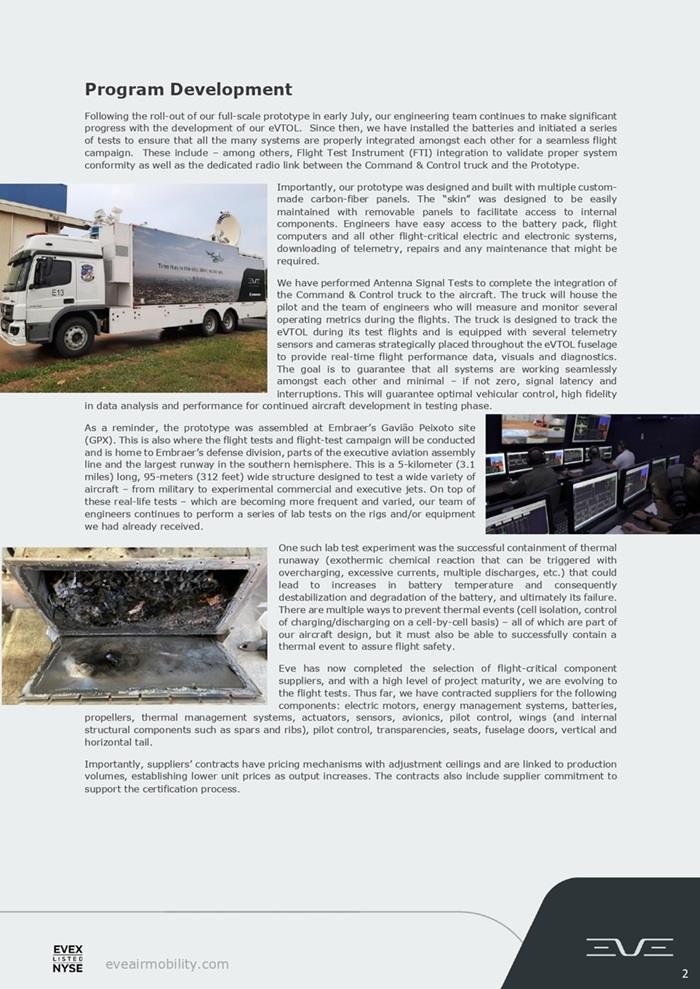
Milestones checklist
• Conclude first airframe prototype assembly / initiate test campaign
As mentioned previously, our engineering team
has completed the assembly of our first full-scale
prototype in Embraer’s Gavião Peixoto facility. The
prototype was officially presented to the public,
investors, customers and partners at a July 3rd
event, and a video of the event was unveiled at the
Farnborough Air Show.
The remote-controlled eVTOL will be used to
validate the performance characteristics of the
many tests we have performed over the years –
either with sub-scale models, individual rigs, windtunnel or Computational Fluid Dynamics (CFD)
tests to estimate lift, aerodynamic drag, sound
emission, energy consumption, component
vibration, etc. The findings will be used to further
refine the commercial versions of the aircraft.
After the July roll-out and battery installation, our engineering team conducted a series of tests in the prototype,
as part of the protocol for flight readiness. These tests include high and low voltage tests to isolate potential
leakage in the system, a successful thermal-runaway containment test in the energy pack, as well as oscillatory
load tests in the rotor rig with different propeller configurations to maximize the power/energy consumption
equation and to minimize noise emission and vibration. Besides that, all flight instruments were integrated for
seamless interoperability. Lastly, our team of engineers linked the Command & Control station to the prototype
via a dedicated radio signal – this will allow the pilot to control the aircraft remotely and will feed telemetry and
images to the truck for later analyses.
• Definition of Certification Basis and Means of Compliance
On November 1st
, Brazil’s Civil Aviation Authority (ANAC) published the Basis of Certification for Eve’s eVTOL in
the country. This is a major milestone for the eVTOL industry and will allow Eve to progress towards ANAC type
certification (TC) and seek validation with the FAA (Federal Aviation Administration).
ANAC’s Basis of Certification establishes the first set of airworthiness criteria for eVTOLs in Brazil and follows
Eve’s application for TC in 2022. It is a standard process for developing a new certification basis and an important
milestone in the project.
Following the definition of the airworthiness criteria, Eve will focus on defining with ANAC the Means of Compliance
– these are specific tests, analyses and simulations that need to be successfully performed for TC to be granted.
These tests are performed to prove the aircraft design, and that construction meets the safety standards laid out
in the Basis of Certification.
On October22, the FAA issued the Special Federal Aviation Regulation (SFAR) that details the final rules for
Advanced Air Mobility (AAM) and covers eVTOL. In general, the new FAA SFAR has been well received by the US
Urban Air Mobility market, as it simplifies pilot training process and allows single control eVTOLs, among other
advances.
In addition to the engineering prototype rolled-out in July, Eve plans to deploy five prototypes for its certification
campaign, with an option for a sixth test aircraft deployed if needed. And while each prototype will have a specific
intended goal and distinct role in the campaign, they all serve a common goal – to prove the safety and reliability
of Eve’s eVTOL design for commercial operations.
Importantly, these aircraft will be piloted and have the systems/sub-systems and redundancies that will be
present in the commercial aircraft. For instance, they will be fitted with passenger and pilot seats, the batteries
placed between the passenger seats and the cargo area. This configuration will ensure that the prototypes have
the same dimensions and physical characteristics – including weight and center of gravity of the commercial
aircraft, to ensure high fidelity in the certification campaign vis-à-vis the expected performance of the commercial
aircraft at EiS
eveairmobility.com
3
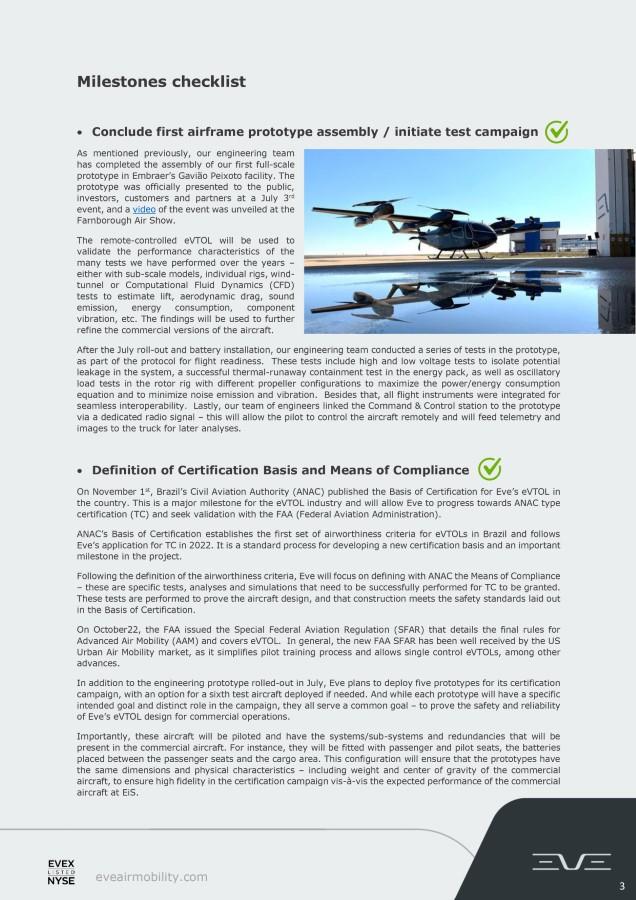
In general terms, the prototypes are expected to excel in ground vibration tests (GVT) to be subsequently
validated in flight vibration tests (FVT). At each flight test point – and aided by telemetry collected throughout
the process, engineers will decide to proceed to subsequent stages. If successful, they will systematically expand
the flight envelope of the aircraft with greater speeds, at various altitudes. The aircraft will also be tested for
flutter.
Flight flutter tests are a type of load test performed on aircraft during the certification process to evaluate their
structural strength and stability. The tests involve measuring the aircraft's natural frequencies and damping
coefficients while increasing the speed in stages. This is a critical stage in the certification process, as it ensures
that the aircraft is flutter free throughout its entire flight envelope. This is a hazardous phase because it requires
flying close to flutter speeds to detect instabilities. Aeroelastic stability can also change abruptly with only a few
knots' change in air speed. The basic objective of a flight flutter test is to determine the speed at which critical
flutter would occur, and the type of flutter involved, from measurements made on the aircraft in flight at speeds
safely below the critical speeds.
The published airworthiness criteria are a result of a months-long public commenting phase and follows months
and countless interactions among all interested parties – including Eve, Embraer, other eVTOL OEMs, as well as
the FAA and EASA and the general population. ANAC has compiled all comments to align and harmonize different
requirements.
Once TC is granted, Eve plans to seek validation by other authorities. The company formalized the validation with
the FAA in 2023, which enables Eve to actively work with the FAA during the certification process with ANAC,
pursuing the concurrent issuance of each authority’s TC.
• Define configuration of eVTOL factory; secure manufacturing finance
Last year, we selected a former Embraer site in the city of Taubaté, São Paulo – Brazil, to house our first
production site, with a total expected output of up to 480 units/year. We are planning to expand the site’s capacity
on a modular basis, with four equally-sized modules – each with a capacity for 120 units/year, for a disciplined
and capital-efficient investment approach.
We intend to start preparing the facility to accommodate our initial production efforts shortly and estimate these
customizations will consume approximately $80 to 90 million. We have engaged Brazil’s National Development
Bank (BNDES) and secured the necessary funding for this project, completing then another important milestone
we had previously set for the year.
eveairmobility.com
4
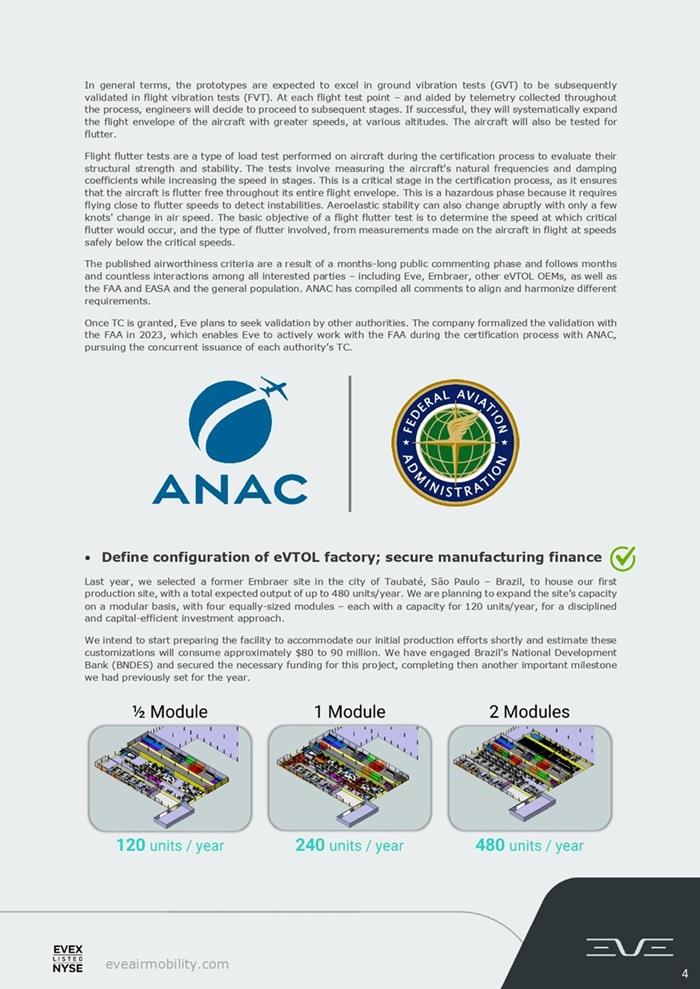
While the Taubaté site will require specialized tooling and equipment for the manufacturing process of eVTOLs,
as well as some civil construction and an upgrade of facilities for aircraft and equipment tests, the building itself
is complete and already operational. By leveraging on one of Embraer’s sites in Brazil – rather than having to
build a new site from the ground up, we aim to implement relatively quick and inexpensive upgrades.
• Achieve 2024 total cash consumption between $130/$170 million
With intensifying program development efforts, continued supplier selection, assembly of our prototype, and
necessary investments in the production site, Eve expects a total cash consumption between $130 and $170
million in 2024. This compares to $59.9 million invested in the program in 2022 and $94.7 million in 2023. As of
3Q24, Eve had deployed $101.3 million in the program (vs. $70.2 million in 9M23).
The additional program activities will require an increase in the number of engineering hours – via our MSA with
Embraer as well as direct Eve personnel, and the acquisition of raw materials and parts/components for our
prototypes. Additionally, we will increase engagement with selected suppliers and receive equipment during the
remainder of 2024. This will trigger additional cash consumption in the coming months.
While we continue to expect sequentially higher investments and expenses in the quarters ahead due to
intensifying engineering engagement as well as potential supplier payments, we are confident that our capital
resources and liquidity – which includes the liquidity events executed recently, will be sufficient to fund our
operations, design and certification efforts through multiple years ahead.
Eve introduces aftermarket services portfolio, TechCare
Eve launched a fully integrated aftermarket services portfolio for efficient and safe UAM operations, TechCare.
This is a pioneer all-in-one suite of solutions designed to streamline eVTOL operations by providing the industry’s
most comprehensive services, expert customer support, and cutting-edge operational solutions.
TechCare was built on Embraer’s extensive aviation expertise and offers a unique portfolio of products and
services for customers with a global footprint and local presence. The aftermarket portfolio consists of technical
support and solutions, Maintenance, Repair and Overhaul (MRO) services, parts and battery solutions.
Importantly, TechCare will also include advanced training services for pilots, mechanics and ground handling
personnel and flight-operation solutions, available to operators via a digital platform.
The training service is powered by Eve and Embraer-CAE Training Services (ECTS), a joint venture between
Embraer and CAE Inc., with a proven track record of successful operations since 2007.
The app is a user-friendly system, the functions easily controllable and it is an all-inclusive digital platform
designed for reliable operations anywhere.
Among other offerings, the TechCare portfolio of services will include eVTOL health monitoring with real-time
data collection capabilities to help improve fleet performance. This will be used to run predictive maintenance,
schedule aircraft down time and optimize spare-parts inventory management. The system is connected to
operators, manufacturers, service centers and suppliers and will help facilitate repairs, and replacement of
different components, including batteries. Ultimately, TechCare will increase aircraft availability and reduce
operational costs.
eveairmobility.com
5
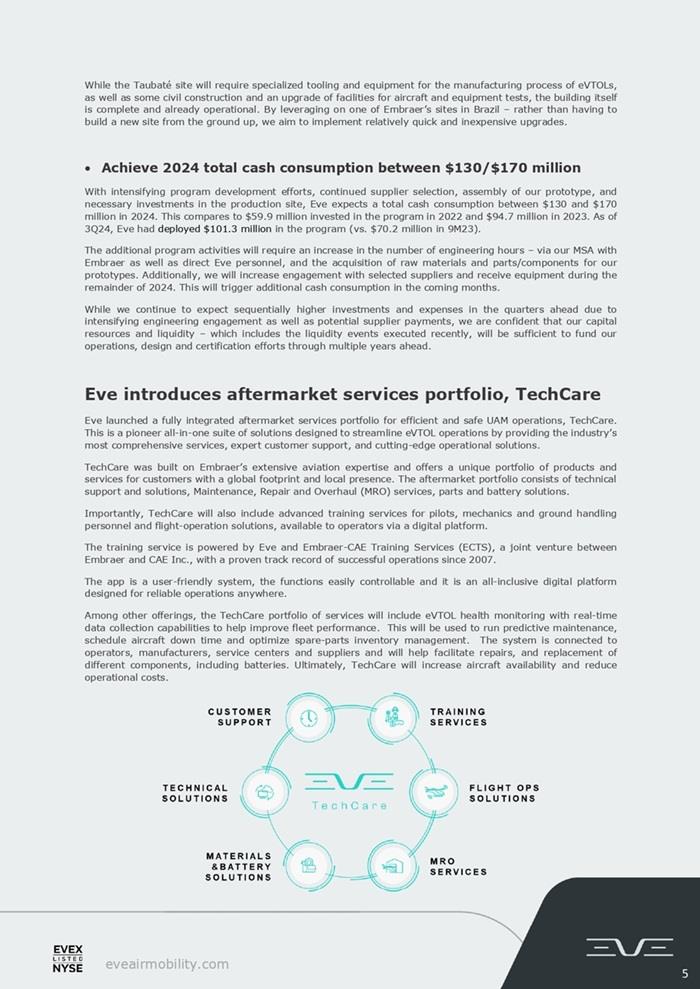
The portfolio was designed for operational efficiency and safety with a unique customer-centric approach. The
solutions were developed based on aerospace expertise and diverse interactions with customers and partners.
The result is a first-of-its-kind offer that will keep customers’ eVTOLs flying at a high availability rate.
Eve TechCare’s service and support solutions will cover all the operational aspects necessary to ensure the daily
eVTOL operation. This includes access to a 24/7 customer care center, pilot and mechanic training, entry into
service support, technical and operational publications, material and battery services, aircraft health monitoring,
and MRO services. Eve will offer a different support level approach to guarantee that each customer can benefit
from our solutions according to their needs, ensuring efficiency and profitability.
Click here to watch the video and learn more about Eve TechCare
Visit Eve TechCare’s webpage here: https://www.eveairmobility.com/techcare/
Latest Highlights
Eve Selects Embraer-CAE Training Services as Training Partner
Eve and Embraer-CAE Training Services (ECTS), a joint venture
between Embraer and CAE Inc. (CAE), announced on October 31
that ECTS has been selected as the training provider for Eve’s
electric vertical take-off and landing (eVTOL) aircraft pilots,
maintenance technicians and ground handling personnel. The
services will be part of the recently announced Eve TechCare, the
company’s all-in-one service portfolio for eVTOLs.
The joint venture between Embraer and CAE, established in 2007,
began with a contract to provide pilot and ground crew training for
Embraer’s Phenom 100 and Phenom 300 customers. Today, the JV
operates nine full-flight simulators globally, with more slated for
2025. Earlier this year, it marked a significant milestone by
launching the first E2 full-flight simulator in Asia, further
strengthening its growth trajectory. Leveraging CAE’s extensive global network of training centers, ECTS ensures
comprehensive training coverage, delivering the high-quality customer experience that has become a hallmark
of its service.
Eve takes advantage of Embraer’s 55 years of experience in designing, certifying, and manufacturing state-ofthe-art aircraft. Its customers will also benefit from having access to an existing global service and support
network, which is critical to ensuring reliable, safe, and efficient UAM operations.
Eve Announces $50 Million Bank Loan to Support eVTOL Development
Eve announced on October 30, a $50 million loan from Citibank. The funding, which will strengthen Eve's balance
sheet, will support the company’s aircraft research and development program.
With this additional loan, Eve's 3Q24 pro-forma liquidity increases to ~$445 million, when combined with recently
announced $96 million in equity financing from a diverse group of global industrial companies and financial
investors in July 2024. Eve also recently announced a new $88 million credit line agreement with Brazil’s National
Development Bank (BNDES) to fund the development of the company’s aircraft production facility in Taubaté, in
the state of São Paulo, Brazil.
Eve Presents Eve TechCare at MRO Europe
On October 22, Eve announced at MRO Europe in Barcelona the launch of its fully integrated aftermarket services
portfolio for efficient and safe Urban Air Mobility (UAM) operations. Eve TechCare is a pioneer all-in-one suite of
solutions designed to streamline electric vertical take-off and landing aircraft (eVTOL) operations by providing
the industry’s most comprehensive services, expert customer support, and cutting-edge operational solutions.
eveairmobility.com
6

Backed by Embraer’s 55 years of
history and aerospace industry
expertise, Eve TechCare offers a
unique way of serving customers
with a global footprint and local
presence. The aftermarket portfolio
consists of technical support and
solutions, MRO services, parts and
battery solutions, as well as training
services and flight operation
solutions, which operators will access
through a digital platform.
Eve TechCare’s service and support
solutions will cover all the
operational aspects necessary to
ensure the daily eVTOL operation.
This includes access to a 24/7
customer care center, pilot and
mechanic training, entry into service
support, technical and operational publications, material and battery services, aircraft health monitoring, and
MRO services. Eve will offer a different support level approach to guarantee that each customer can benefit from
our solutions according to their needs, ensuring efficiency and profitability.
Eve Secured $88 million from BNDES to Finance eVTOL Manufacturing
On October 15, Eve announced that the company secured a $88 million (US$-equivalent amount; loan in Brazil’s
local currency, BRL) loan agreement with Brazil’s National Development Bank (BNDES) to fund the development
of the company’s electric vertical take-off and landing (eVTOL) aircraft production facility in Taubaté, in the state
of São Paulo, Brazil. Under the BNDES Mais Inovação program, the financing reinforces BNDES’ commitment to
supporting innovative projects and Eve’s advancements in fostering decarbonization and the urban air mobility
(UAM) industry.
The manufacturing facility financing builds upon the successful partnership between Eve and BNDES following
the 2022 approval of a $95 million (as of September 30, 2024) line of credit to support Eve’s eVTOL development
program. The new funding agreement is structured by sub-credits from domestic and international sources,
including the bank’s foreign currency funds, and a maturity of 16 years.
With an eventual total expected output of up to 480 aircraft per year, Eve plans to expand the site’s production
capacity on a modular basis, with four equally sized modules of 120 aircraft per year. This will provide for a
disciplined, capital-efficient investment approach as the market grows.
Eve and Siemens Energize U.S. Advanced Air Mobility Industry
On July 23, Eve Air Mobility and Siemens Smart Infrastructure, a manufacturer of electrical and digital
technologies and solutions, announced through a Memorandum of Understanding, that they are teaming up to
evaluate the electrical infrastructure and energy management services needed to support safe, efficient and
scalable eVTOL operations. Together, the two companies will collaborate on evaluating the energy service needs
for eVTOL aircraft and demand for these services across the United States as the Advanced Air Mobility (AAM)
industry grows.
The AAM industry is rapidly taking shape around the world and now stands on the cusp of commercialization.
Integrating AAM into the existing transportation ecosystem offers an additional zero-emission option for urban
mobility, reduces travel time, and accelerates decarbonization efforts. Similarly, eVTOL technologies are expected
to transform communities through investments in infrastructure, electrification, new jobs and freedom of
movement, thereby creating a Target Addressable Market anticipated to be greater than US$760 billion by 2040.
The energy services Siemens and Eve are exploring will support the electrical infrastructure and provide fleet
operators with the confidence to launch and scale AAM operations. These models would ultimately help minimize
upfront capital impacts, thereby accelerating the transition to AAM while overcoming potential obstacles to entry.
eveairmobility.com 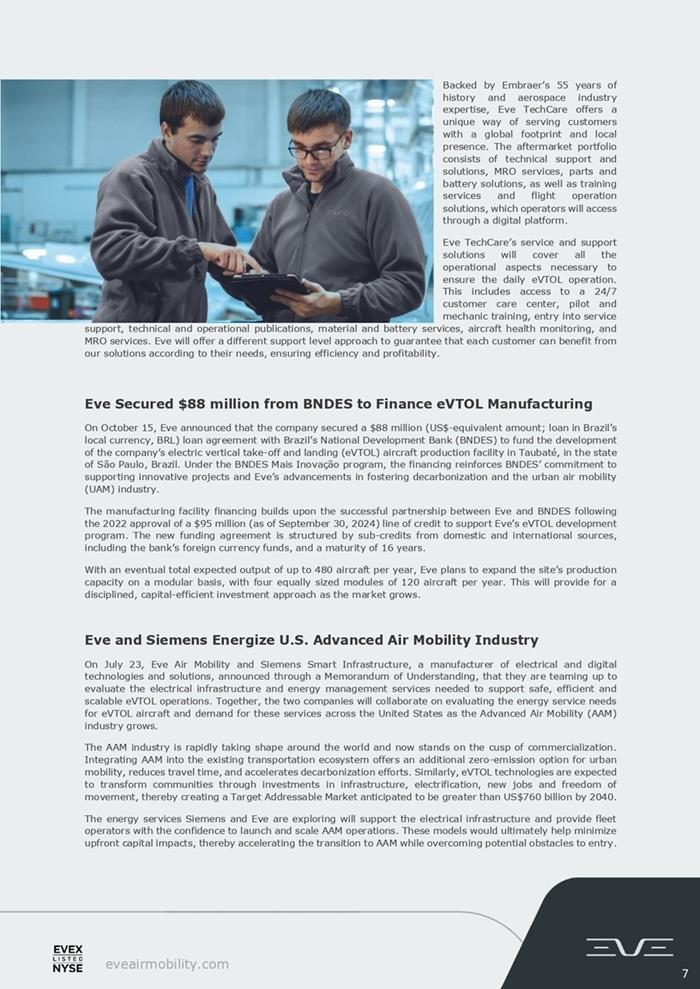
Backlog, Order Pipeline
eVTOL Orders
Currently, Eve’s order pipeline totals approximately 2.9K units, with a total nonbinding backlog value of approximately $14 billion. This value is based on a list
price methodology that is a common practice in the aviation industry and
incorporates internal and external factors to define a standard price. Eve will
not disclose specific deal prices and will use the list price as a reference for
future transaction values. Our initial order pipeline is based on non-binding LOIs
and is therefore subject to change, consistent with customary aviation practices.
Eve’s current client base is comprised of 30 customers, with no client
representing more than 14% of the total order book, including options. The
order book is further diversified by the industries in which these customers
operate, with fixed wing operators representing 39%, helicopter operators 27%,
lessors 17% and ride-sharing platforms 12%.
Lastly, Eve has received LOIs from clients in 12 different countries spread over
five continents around the globe. The Americas is home to close to two thirds of
Eve’s backlog (North America is 46% and South America 17%), while Europe
represents 18% of the LOIs, and Asia 9%.
TechCare
Eve is replicating elements of Embraer’s proven business model, namely the design, manufacturing, and sale of
aircraft. In addition, Eve will also provide MRO services on an agnostic basis worldwide. With that, Eve is uniquely
positioned to serve its customers by leveraging Embraer’s global presence with local support and has secured
non-binding contracts for services solutions across the world with 15 customers. Combined, these customers
have placed Letters of Intent (LOI) for approximately 1.2k of our eVTOLs, or 41% of our order book.
These contracts include MRO, training, battery services, data integration and spare parts solutions, as well as
component repair. These functions will be enhanced by a Memorandum of Understanding (MOU) signed with DHL
Supply Chain to optimize supply chain to service centers. The MOU will also focus on batteries and the specific
requirements for transporting, storing, and disposing of those devices.
eveairmobility.com
8
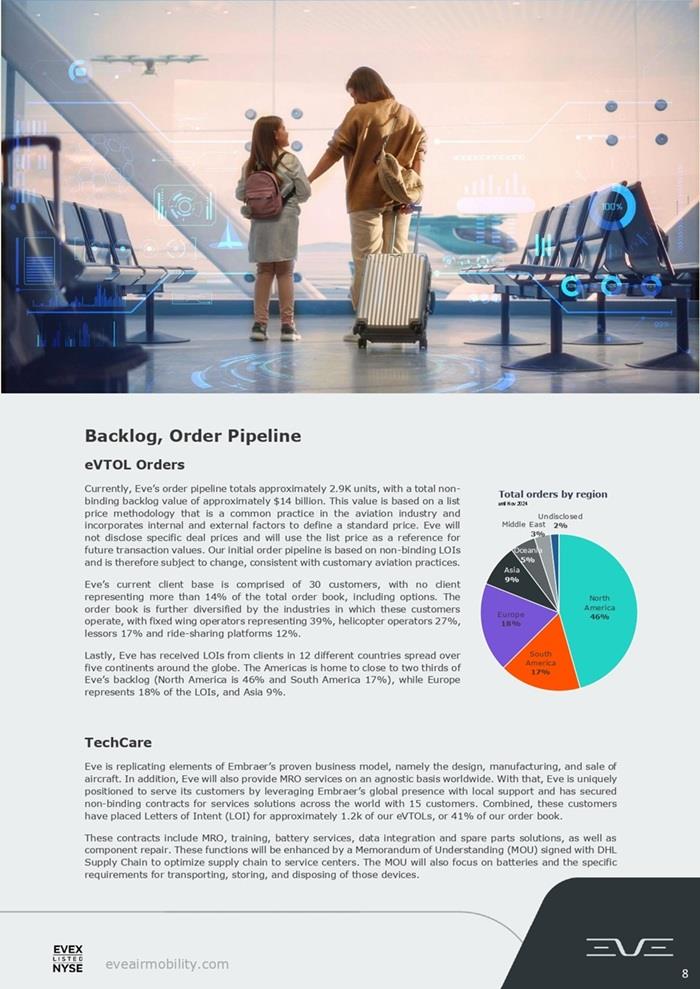
These non-binding services contracts are estimated to bring potential revenues of $1.6 billion during the first few
years of vehicle operation, and because of our agnostic approach to the maintenance business, Customer Services
revenues could precede the first delivery of our eVTOL.
Lastly, and in addition to eVTOL sales and Customer Services solutions, Eve is also engaged in developing Vector
and has signed LOIs from 23 customers globally.
Eve’s eVTOL concept and design
Rather than relying on traditional combustion engines, eVTOL aircraft are designed to use electric motors, providing
an alternative means of transportation in urban markets that does not produce carbon emissions. Eve’s design uses
a conventional fixed wing and empennage, rotors and a pusher, giving it a practical and intuitive lift-plus-cruise
design, which favors safety, efficiency, reliability and certifiability, while being environmentally friendly.
With an expected range of 60 miles (approximately 100 kilometers), Eve’s aircraft have the potential to not only
offer a sustainable and affordable commute, but also reduce sound levels compared to current conventional
helicopters.
Its human-centered design ensures the comfort of passengers, the pilot and the community by minimizing sound.
The all-electric aircraft features dedicated rotors for vertical flight and a fixed wing to fly in cruise, with no
components required to change position during flight. It will be piloted at launch but evolve towards uncrewed
operations in the future.
9
eveairmobility.com
These non-binding services contracts are estimated to bring potential revenues of $1.6 billion during the first few
years of vehicle operation, and because of our agnostic approach to the maintenance business, Customer Services
revenues could precede the first delivery of our eVTOL.
Lastly, and in addition to eVTOL sales and Customer Services solutions, Eve is also engaged in developing Vector
and has signed LOIs from 23 customers globally.
Eve’s eVTOL concept and design
Rather than relying on traditional combustion engines, eVTOL aircraft are designed to use electric motors, providing
an alternative means of transportation in urban markets that does not produce carbon emissions. Eve’s design uses
a conventional fixed wing and empennage, rotors and a pusher, giving it a practical and intuitive lift-plus-cruise
design, which favors safety, efficiency, reliability and certifiability, while being environmentally friendly.
With an expected range of 60 miles (approximately 100 kilometers), Eve’s aircraft have the potential to not only
offer a sustainable and affordable commute, but also reduce sound levels compared to current conventional
helicopters.
Its human-centered design ensures the comfort of passengers, the pilot and the community by minimizing sound.
The all-electric aircraft features dedicated rotors for vertical flight and a fixed wing to fly in cruise, with no
components required to change position during flight. It will be piloted at launch but evolve towards uncrewed
operations in the future.
9
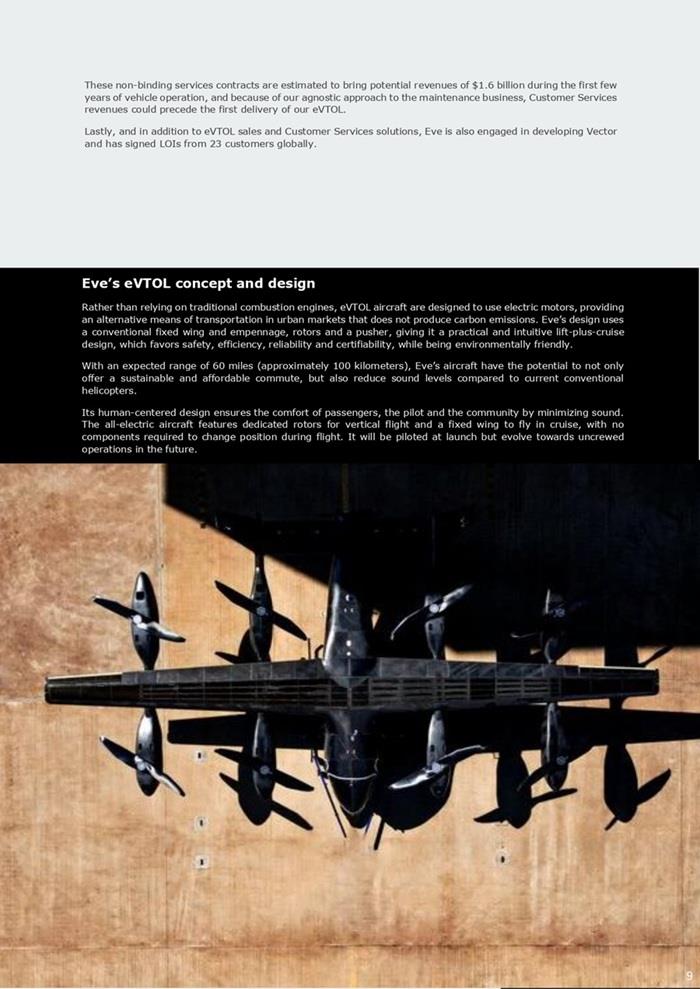
Financial Performance
Income Statement
(Unaudited, US dollars,’000s, except where noted)
Balance Sheet
(Unaudited, US dollars,’000s, except where noted)
Three Months Ended
September 30,
Nine Months Ended
September 30,
2024 2023 2024 2023
Operating expenses
Research and development expenses $ 32,419 $ 28,642 $ 96,191 $ 71,992
Selling, general and administrative expenses 8,411 5,035 20,287 17,822
Total operating expenses 40,830 33,677 116,479 89,814
Operating loss (40,830) (33,677) (116,479) (89,814)
Gain/(loss) from the change in fair value of derivative liabilities 3,990 (854) 12,398 (9,833)
Financial investment income 3,629 2,802 7,961 9,039
Related party loan interest income 430 1,158 2,875 3,149
Interest expense (835) (31) (1,861) (31)
Other (loss)/gain, net (1,744) 489 (921) 672
Loss before income taxes (35,361) (30,112) (96,027) (86,817)
Income tax expense 427 1,098 1,445 1,574
Net loss $ (35,787) $ (31,210) $ (97,472) $ (88,392)
Weighted-average number of shares outstanding – basic and diluted 297,833 275,887 283,484 275,671
Net loss per share –basic and diluted $ (0.12) $ (0.11) $ (0.34) $ (0.32)
September 30, December 31,
2024 2023
ASSETS
Current assets
Cash and cash equivalents $ 24,572 $ 46,882
Financial investments 255,258 111,218
Related party receivables 19 191
Related party loan receivable - 83,042
Other current assets 5,685 889
Total current assets 285,534 242,221
Non-current assets
Property, plant & equipment, net 510 547
Right-of-use assets, net 1,260 508
Deferred income tax, net 1,714 1,714
Other non-current assets 504 348
Total non-current assets 3,988 3,118
Total assets $ 289,522 $ 245,339
LIABILITIES AND EQUITY
Current liabilities
Accounts payable $ 3,916 $ 4,571
Related party payables 31,588 20,208
Derivative financial instruments 1,568 13,965
Other current payables 17,697 13,245
Total current liabilities 54,768 51,989
Non-current liabilities
Long-term debt 68,309 25,764
Other non-current payables 2,779 2,535
Total non-current liabilities 71,089 28,299
Total liabilities 125,857 80,288
Commitments and contingencies
Equity
Common stock, $0.001 par value 298 269
Additional paid-in capital 605,505 509,448
Accumulated deficit (442,138) (344,667
Total equity 163,665 165,051
Total liabilities and equity $ 289,522 $ 245,339
eveairmobility.com
10
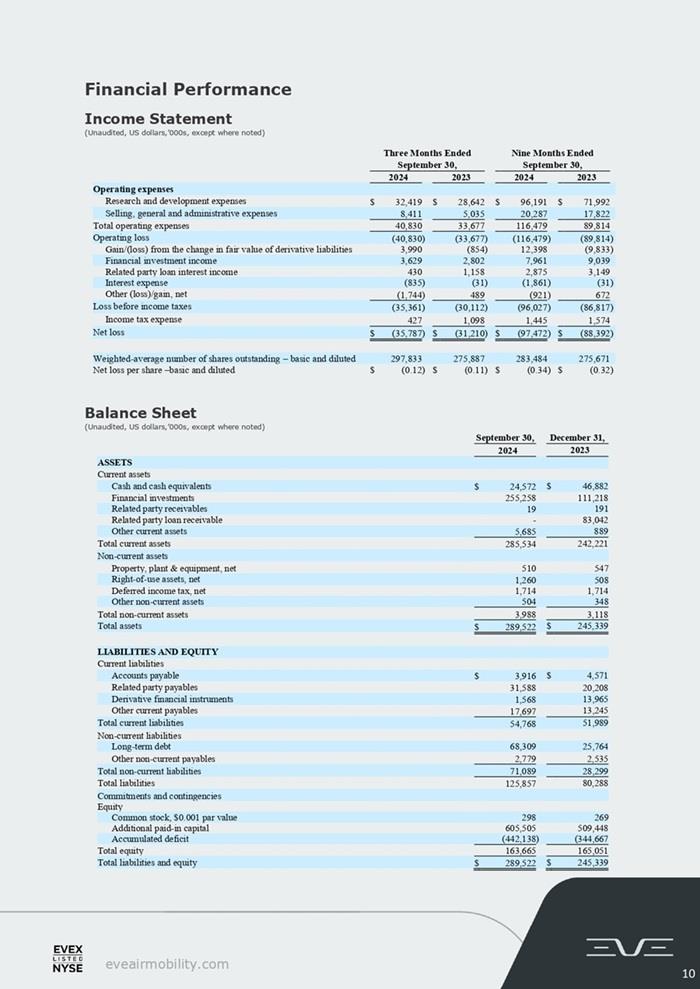
Cash Flow Statement
(Unaudited, US dollars,’000s, except where noted)
Webcast Details
Management will discuss the results on a conference call on Monday, November 4, 2024 at 8:00 AM (Eastern
Time). The webcast will be publicly available in the Upcoming Events section of the company website
(www.eveairmobility.com).
To listen by phone, please dial 1-844-826-3033 or 1-412-317-5185. A replay of the call will be available
until November 18, 2024, by dialing 1-844-512-2921 or 1-412-317-6671 and entering passcode 10191816.
Webcast access here.
Nine Months Ended September 30,
2024 2023
Cash flows from operating activities
Net loss $ (97,472) $ (88,392)
Adjustments to reconcile net loss to net cash used by operating activities
Depreciation and amortization 176 143
Non-cash lease expenses 366 55
Unrealized gain on the exchange rate changes (1,220) (385)
Share-based compensation 2,770 3,320
Warrant expenses - 480
Change in fair value of derivative financial instruments (12,398) 9,833
Changes in operating assets and liabilities
Accrued interest on financial investments, net (5,040) (5,667)
Accrued interest on related party loan receivable, net 2,042 844
Other assets (1,499) (733)
Related party receivables 163 (1,898)
Accounts payable (569) (257)
Related party payables 11,515 8,016
Other payables 3,874 4,644
Net cash used by operating activities (97,290) (69,997)
Cash flows from investing activities
Redemptions of financial investments 60,000 72,500
Purchases of financial investments (199,000) (52,500)
Collection of related party loan 81,000 -
Expenditures for property, plant and equipment (4,001) (168)
Net cash (used) provided by investing activities (62,001) 19,832
Cash flows from financing activities
Proceeds from issuance of common stock, net of fees to investors 94,288 -
Non-investor equity issuance costs (981) -
Proceeds from debt, net 45,246 11,375
Non-creditor debt issuance costs (787) (375)
Tax withholding on share-based compensation - (287)
Proceeds from exercised warrants 9 1
Net cash provided by financing activities 137,774 10,714
Effect of exchange rate changes on cash and cash equivalents (792) 402
Decrease in cash and cash equivalents (22,310) (39,049)
Cash and cash equivalents at the beginning of the period 46,882 49,146
Cash and cash equivalents at the end of the period $ 24,572 $ 10,097
Supplemental disclosure of cash information
Cash paid for
Income tax $ 2,762 $ 875
Interest $ 1,317 $ -
Supplemental disclosure of other non-cash investing and financing activities
Property, plant & equipment expenditures in accounts payable and other accruals $ 41 $ -
Right-of-use assets obtained in exchange for operating lease liabilities $ 1,118 $ 373
Issuance of common stock for vested restricted stock units $ 878 $ 1,366
eveairmobility.com
11
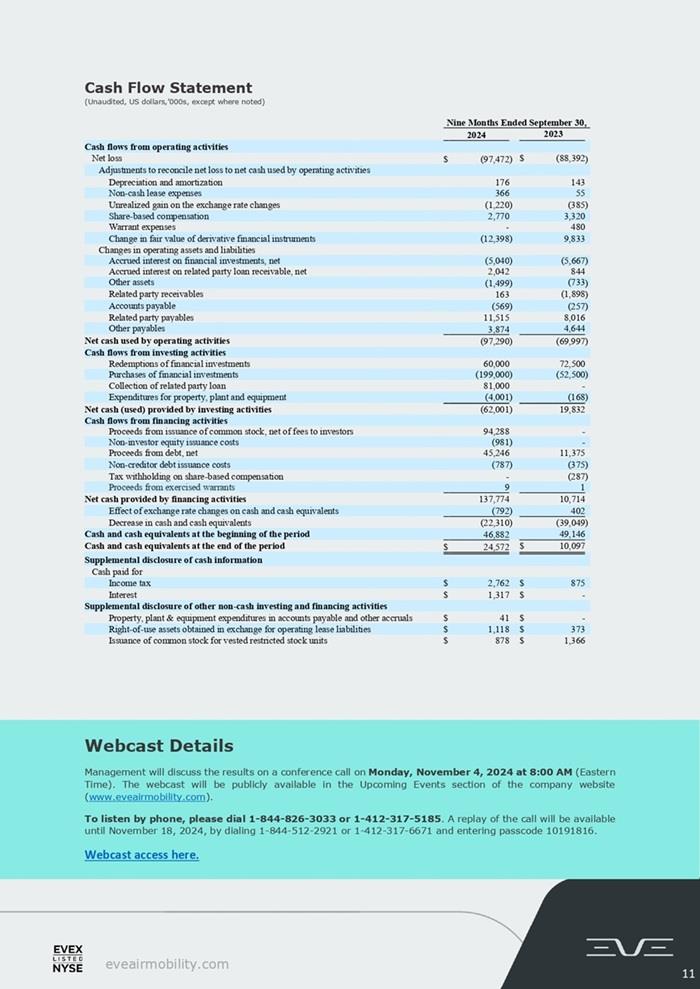
Upcoming Events
Eve senior management is scheduled to attend the following investor events:
Embraer Investor Day – New York (November 18)
UBS Global Industrials and Transportation Conference – Palm Beach, Fl. (December 2-4)
Non-GAAP Financial Measures (Unaudited)
Management uses both generally accepted accounting principles (GAAP) and non-GAAP financial measures to
assess the financial condition of the Company. Management believes certain non-GAAP measures described below
provide investors with additional insight into the Company’s ongoing business performance and financial
condition. These non-GAAP measures should not be considered in isolation or as a substitute for the related GAAP
measures, and other companies may define such measures differently. Investors are encouraged to review the
Company's financial statements and publicly-filed reports in their entirety and not to rely on any single financial
measure.
Free Cash Flow is a non-GAAP measure and is used to review and measure the Company's capital resources
against the substantial cash requirements for operations, which can be useful for an investor to assess the
Company's liquidity position or needs. Its most comparable GAAP measure is Net Cash used by operating
activities. Free Cash Flow is calculated as net cash used by operating activities reduced by expenditures for PP&E,
as provided in the “Key Financial Indicators” table on page 1.
Management also uses a non-GAAP measure called "total liquidity" to track the Company’s access to capital
resources. Total liquidity is defined and measured as the sum of cash and cash equivalents, financial investments,
related party loan receivable, and available debt. Cash equivalents include deposits in bank deposit certificates
issued by financial institutions in Brazil that are immediately available for redemption and fixed term deposits in
US Dollars with original maturities of 90 days or less. Financial investments include debt securities with maturities
greater than 90 days but less than 365 days. The related party loan receivable from Embraer Aircraft Holdings,
Inc. has an original term of 12 months, is callable by the Company at any time, and can be extended upon mutual
written agreement by the parties. The remaining borrowing availability from the BNDES loans is fully committed
to the Company. The following table reconciles total liquidity used by management:
Total Liquidity
(Unaudited, US dollars, millions)
Cash Flow
(Unaudited, US dollars, millions)
September 30, 2024 December 31, 2023
Cash and Cash Equivalents $ 24.6 $ 46.9
Financial Investments 255.3 111.2
Related Party Loan Receivable - 83.0
Undrawn BNDES Loans 25.3 75.1
Total Liquidity $ 305.2 $ 316.3
Net cash used by operating activities $ (97.3) $ (70.0)
Net cash (used) provided by investing activities $ (62.0) $ 19.8
Net cash provided by financing activities $ 137.8 $ 10.7
eveairmobility.com
12
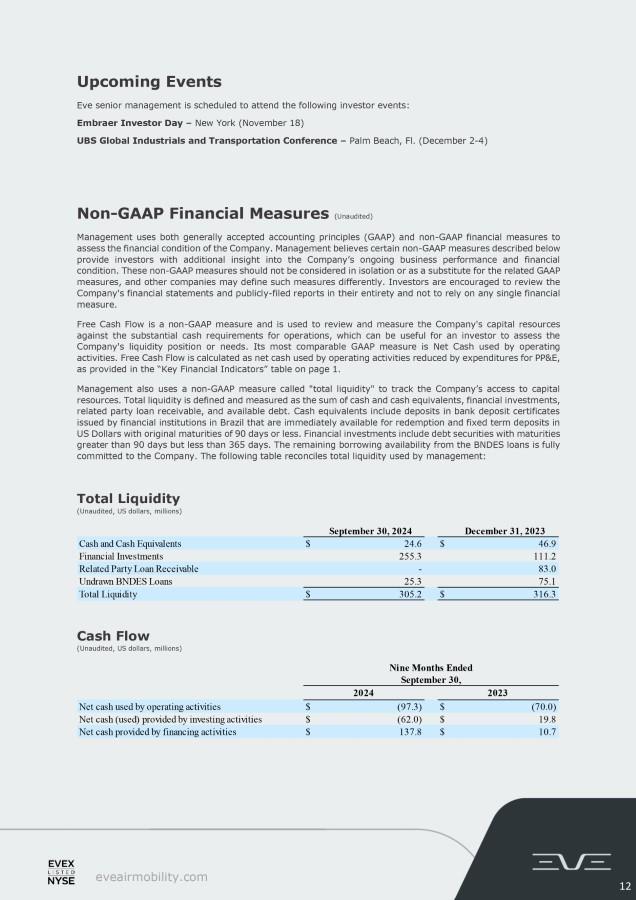
Glossary
ACMI – Aircraft, Crew, Maintenance and Insurance
AL – Airworthiness Limitations
AMP – Aircraft Maintenance Program
ANAC – Agência Nacional de Aviação Civil (National
Agency of Civil Aviation)
ATC – Air Traffic Control
ATM – Air Traffic Management
Capex – Capital expenditures are funds used by a
company to acquire, upgrade, and maintain physical
assets such as property, plants, buildings,
technology, or equipment
COGS – Cost of Goods Sold
ConOps – Concept of Operations
CPA – Capacity Purchase Agreements
DMC – Direct Maintenance Cost
EASA – European Union Aviation Safety Agency
EIS – Entry Into Service / Environment Impact
Statement
Embraer – A global aerospace company
headquartered in Brazil, Embraer has businesses in
Commercial and Executive aviation, Defense &
Security and Agricultural Aviation. The company
designs, develops, manufactures and markets
aircraft and systems, providing Services & Support
to customers after sales.
Embraer is the leading manufacturer of commercial
jets up to 150 seats and the main exporter of high
value-added goods in Brazil. The company maintains
industrial units, offices, service and parts distribution
centers, among other activities, across the Americas,
Africa, Asia and Europe.
eVTOL – electric Vertical Take Off and Landing
aircraft
FAA – Federal Aviation Administration
GAMA – General Aviation Manufacturers Association
IMC – Instrument Meteorological Conditions
LOI – Letter of Intent for new aircraft orders and/or
business partnership
MEL – Minimum Equipment List
MOU – Memorandum of Understanding
MPP – Master Phase Plan
MRB – Maintenance Review Board
MRO – Maintenance, Repair and Operations
MSA – Master Service Agreement
OEM – Original Equipment Manufacturer
PBH – Pay-by-the-hour contracts
PDP – Pre-Delivery Payment
POC – Proof of Concept
PSA – Product Support Agreements
QMS – Quality Management System
Research and Development (R&D) –Expenses
related to the development of technologies of our
eVTOL aircraft and UATM solutions
S&S MPP – Service and Support Master Phase Plan
SoS – System of Systems
SoSE – System-of-Systems Engineering
SVO – Simplified Vehicle operation
T&M – Time and Materials contracts
TRL – Technology Readiness Level
UAM – Urban Air Mobility
UAS – Unmanned Aircraft Systems
UATM – Urban Air Traffic Management
About Eve Holding, Inc.
Eve is dedicated to accelerating the Urban Air Mobility ecosystem. Benefitting from a start-up mindset, backed
by Embraer S.A.’s more than 50-year history of aerospace expertise, and with a singular focus, Eve is taking a
holistic approach to progressing the UAM ecosystem, with an advanced eVTOL project, comprehensive global
services and support network and a unique air traffic management solution. Since May 10, 2022, Eve has been
listed on the New York Stock Exchange, where its shares of common stock and public warrants trade under the
tickers “EVEX” and “EVEXW”. The information on, or accessible through, any website referenced herein is not
incorporated by reference into, and is not a part of, this release.
eveairmobility.com
13
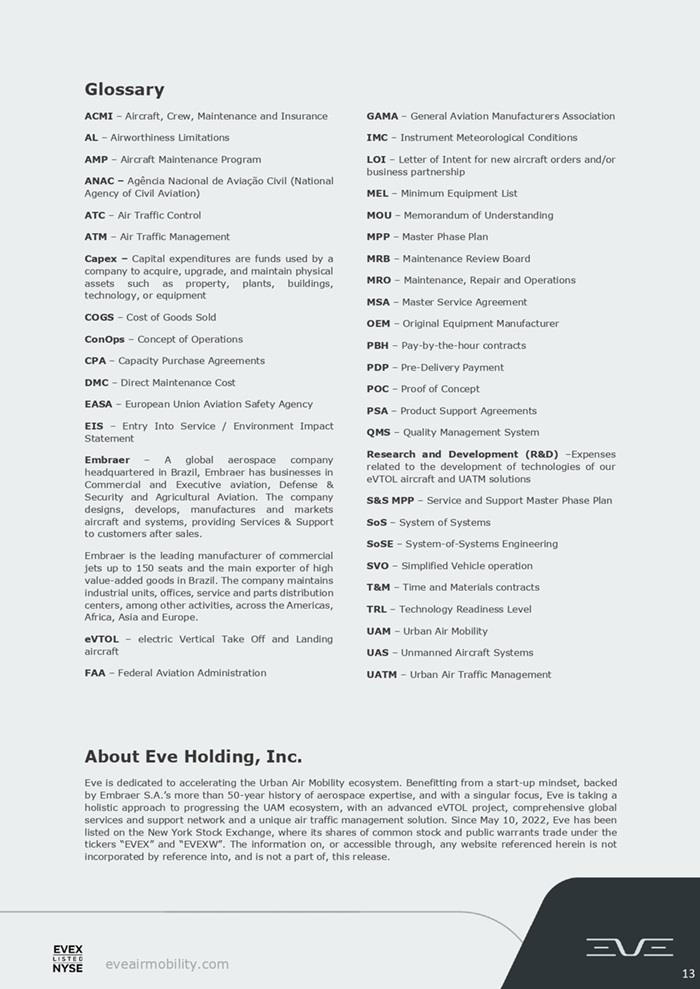
Forward Looking Statements
Certain statements contained in this release are forward-looking statements within the meaning of the Private
Securities Litigation Reform Act of 1995. These forward-looking statements may be identified by words such as
“may,” “will,” “expect,” “intend,” “anticipate,” “believe,” “estimate,” “plan,” “project,” “could,” “should,” “would,”
“continue,” “seek,” “target,” “guidance,” “outlook,” “if current trends continue,” “optimistic,” “forecast” and other
similar words or expressions. All statements, other than statements of historical facts, are forward-looking
statements, including, but not limited to, statements about the company’s plans, objectives, expectations,
outlooks, projections, intentions, estimates, and other statements of future events or conditions, including with
respect to all companies or entities named within. These forward-looking statements are based on the company’s
current objectives, beliefs and expectations, and they are subject to significant risks and uncertainties that may
cause actual results and financial position and timing of certain events to differ materially from the information
in the forward-looking statements. These risks and uncertainties include, but are not limited to, those set forth
herein as well as in Part I, Item 1A. Risk Factors and Part II, Item 7. Management’s Discussion and Analysis of
Financial Condition and Results of Operations of the company’s most recent Annual Report on Form 10-K, Part
I, Item 2. Management’s Discussion and Analysis of Financial Condition and Results of Operations and Part II,
Item 1A. Risk Factors of the company’s most recent Quarterly Report on Form 10-Q, and other risks and
uncertainties listed from time to time in the company’s other filings with the Securities and Exchange
Commission. Additionally, there may be other factors of which the company is not currently aware of that may
affect matters discussed in the forward-looking statements and may also cause actual results to differ materially
from those discussed. The company does not assume any obligation to publicly update or supplement any
forward-looking statement to reflect actual results, changes in assumptions or changes in other factors affecting
these forward-looking statements, other than as required by law. Any forward-looking statements speak only as
of the date hereof or as of the dates indicated in the statement.
Investor Relations:
Lucio Aldworth
Caio Pinez
[email protected]
https://ir.eveairmobility.com/
Media:
[email protected]
14
